Proper implant care plays a crucial role in the osseointegration process, helping to stabilize the implant post and increase the durability of the restoration. After implantation, patients need to follow their dentist’s instructions to ensure a smooth healing process. The article below will provide you with detailed guidelines on how to care for your teeth after dental implant placement, ensuring a safe and effective recovery.
Dietary Regimen After Dental Implant Placement
The post-implant diet plays an important role in the integration of the implant with the jawbone, promoting faster wound healing and preventing implant infection. So, how long after dental implant placement can you eat, and what should you eat? Below are detailed instructions for each stage after implant placement.
Immediately After Dental Implant Placement (First 24 Hours)
After implant placement, the jawbone area might be slightly sore, but this is a normal reaction. During the first 24 hours, prioritize liquid foods such as porridge, soup, broth, etc., and drink plenty of water to support the healing process. Avoid hard, chewy, or excessively hot/cold foods to prevent affecting the implant site.

2 – 3 Days After Implant Placement
At this stage, the wound has started to stabilize, but you still need to maintain a soft and gentle diet. You can supplement with post-implant beverages and nutrient-rich fruits to aid recovery. Avoid using straws as they can create suction and affect the implant site.
After 2 Weeks of Implant Placement
After about 2 weeks, the wound has almost healed, and discomfort has significantly reduced. You can resume normal eating habits, but still need to avoid strong impacts on the implant area of the jawbone to prevent implant infection. Additionally, ensure adequate post-implant vitamin intake to support gum tissue regeneration and maintain oral health.
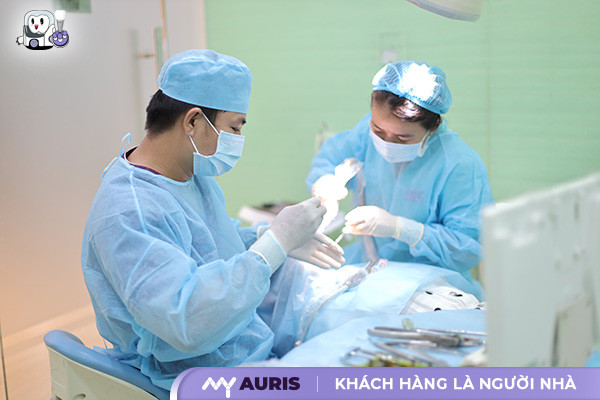
Implant Placement Procedure – Safe, Painless Steps
Dental implant placement is a modern tooth restoration method that needs to be performed according to a scientific procedure to minimize implant complications, ensure safety, and reduce implant pain during and after treatment.
Standard Medical Dental Implant Placement Steps:
Step 1: Implant consultation, general examination, implant X-ray, and treatment planning.
Step 2: General health check-up to ensure eligibility for the procedure.
Step 3: Implant post placement with the assistance of implant anesthesia for maximum pain reduction.
Step 4: Follow-up implant examination after 1 – 2 weeks to check the healing rate.
Step 5: Impression taking for implant-supported crowns after 2 – 6 months when the jawbone has fully integrated with the implant post.
Step 6: Permanent crown placement after 5 – 7 days.
Step 7: Regular implant follow-ups every 4 – 6 months to check stability.
Is Implant Placement Painful?
Thanks to implant anesthesia techniques, the tooth placement process is almost painless. After implant placement, patients may feel mild discomfort for the first 2-3 days. The dentist will prescribe pain relievers and provide proper oral care instructions. If prolonged or unusual pain occurs, visit the dental clinic immediately for timely treatment.
What to Avoid Eating After Dental Implant Placement for Faster Wound Healing?
After dental implant placement, diet plays a crucial role in the recovery process. Below are foods that need to be limited to protect the implant site and ensure oral and general health:
- Foods that are too hot or too cold: Can delay wound healing and cause prolonged bleeding.
- Spicy or sour foods: Irritate the gum area, easily causing inflammation and discomfort.
- Alcohol, beer, and carbonated drinks: Limit for at least 1 week after implant placement to avoid affecting the implant integration process.
- Hard, chewy foods: Exert strong pressure on the newly placed implant area, which can damage the oral region.
Common Symptoms After Implant Placement
After implant placement, some common symptoms include pain, swelling, bleeding, numbness of the lips or tongue, and difficulty opening the mouth. Pain appears when the anesthetic wears off, lasting a few days and depending on the location and individual’s constitution. Swelling usually occurs within the first 24 hours, peaking on days 2-3, then gradually subsiding. Bleeding is also a natural phenomenon for several hours after surgery. Numbness of the lips or tongue can occur if the implant area is near a nerve and can last from several weeks to months. Difficulty opening the mouth is usually due to pain and swelling, which typically decreases after a few days.
Pain
Cause: Pain is a very common symptom after implant placement in the upper jaw, lower jaw, wisdom teeth, incisors, or any other location. Dental implant placement is a surgical procedure that involves the jawbone and gum tissue; therefore, the occurrence of pain after implantation is normal. The level of pain can vary depending on the implant site, jawbone condition, the dentist’s technique, and the individual’s body.
Onset Time: Pain usually appears immediately after the anesthetic wears off and can last for the first few days after surgery.

Swelling
Cause: Swelling is a natural reaction of the body after dental implant surgery. The implant placement process involves intervention in the gum tissue, thereby causing swelling.
Onset Time: Swelling usually appears within the first 24 hours after surgery and may peak after 2-3 days. After that, the swelling will gradually subside.
Bleeding
Cause: Bleeding after implant placement is a common phenomenon. Since implant placement is an invasive surgical procedure, bleeding after implant placement is normal.
Onset Time: Bleeding may occur within the first few hours after surgery and typically stops on its own thereafter.
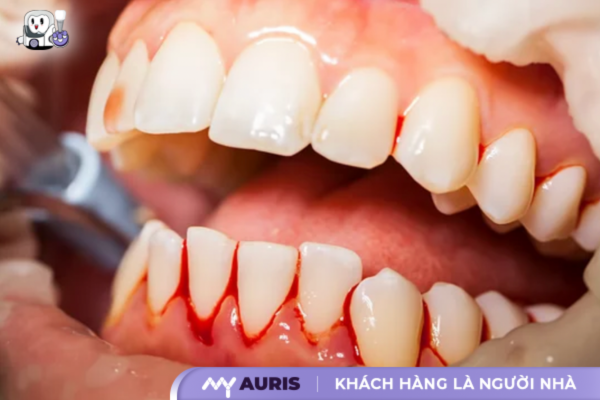
Numbness of Lips, Tongue
Cause: Numbness of the lips and tongue after implant placement, especially in the lower jaw, is due to the implant site being near a nerve. During the surgical procedure, the nerve may be affected, leading to numbness.
Onset Time: Numbness of the lips and tongue can appear immediately after surgery and last for several weeks, months, or longer.

Difficulty Opening Mouth
Cause: Difficulty opening the mouth after implant placement is due to swelling and pain in the surgical area.
Onset Time: This symptom usually appears during the first few days after surgery and gradually subsides as swelling decreases.
Complications After Implant Placement
Although implant placement is a safe dental technique with a high success rate, complications can still occur after the procedure. Understanding these potential complications will help you proactively prevent and address them in a timely manner, ensuring the best implant outcome.
Infection: Infection is a complication that can occur after any surgery, including implant placement. Infection can happen at the implant site, around the implant, or spread to other areas.
| Cause | Symptoms |
|---|---|
| Poor oral hygiene | Severe and prolonged pain |
| Weakened immune system | Swelling that does not subside or increases after a few days |
| Non-sterile implant technique | Pus discharge at the implant site |
| Fever, fatigue |
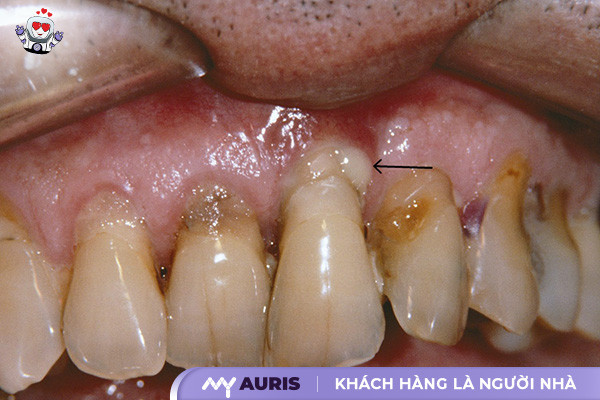
Nerve damage: Nerves in the upper and lower jaws can be damaged during implant placement. Nerve damage can cause numbness, tingling, or pain in the lips, tongue, chin, or cheek.
| Cause | Symptoms |
|---|---|
| Implant placement too close to a nerve | Numbness, tingling, or pain in the lips, tongue, chin, or cheek |
| Inaccurate implant technique | Loss of taste sensation |
Jawbone loss: Jawbone loss is a serious complication that can occur after implant placement, especially in individuals with long-term tooth loss.
| Cause | Symptoms |
|---|---|
| Insufficient jawbone to support the implant | Loose implant |
| Infection around the implant | Gum inflammation around the implant |
| Excessive force on the implant (e.g., chewing very hard food) |
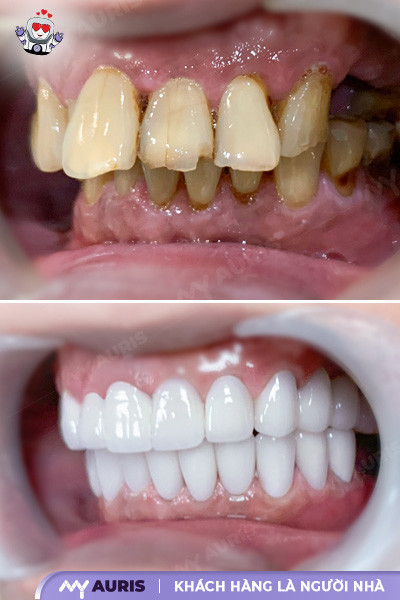
Implant failure: In some rare cases, the implant may not integrate with the jawbone, leading to implant failure.
| Cause | Symptoms |
|---|---|
| Infection | Loose implant |
| Insufficient jawbone | Prolonged pain |
| Excessive force on the implant | Gum inflammation around the implant |
| Tobacco use |
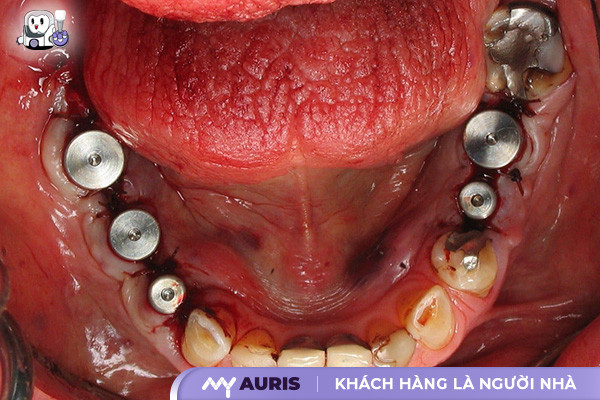
How to Prevent Complications After Implant Placement
Implant placement offers a superior tooth restoration solution. However, to ensure success and minimize complications, understanding prevention methods is crucial.
Below are preventive measures against complications after implant placement that you can apply:
- Choose a Reputable Dental Clinic:
Choosing a reputable dental clinic with highly skilled dentists is a prerequisite for preventing complications.
- Thoroughly research information about the dental clinic: Professional certifications, equipment technology, patient reviews.
- Consult directly with the dentist: Present your expectations and oral health status to receive appropriate advice.

- Comprehensive Oral Health Examination:
A comprehensive oral health examination before implant placement helps the dentist to:
- Assess jawbone condition and nerve location.
- Detect and treat potential oral diseases such as gingivitis, cavities.
- Adhere to Post-Implant Care Instructions:
- Proper oral hygiene: Brush gently, use dental floss, and mouthwash as instructed by the dentist.
- Apply cold and warm compresses to reduce swelling and pain: Follow the doctor’s instructions.
- Take prescribed medication: Take the correct dosage at the right time.
- Diet: Prioritize soft, liquid, easy-to-chew foods. Avoid hard, chewy, hot, cold, spicy, sour, carbonated foods, and stimulants.
- Limit impact on the implant area: Do not touch with hands, do not chew hard food.
- Regular follow-ups: According to the dentist’s appointment schedule to monitor the healing process.
- Maintain a Healthy Lifestyle:
- Quit smoking: Smoking reduces healing ability and increases the risk of infection.
- Control underlying medical conditions: Diabetes, cardiovascular disease, blood pressure, etc., affect the healing process after implant placement.
- Communicate Openly with Your Dentist:
Immediately inform your dentist if you experience any unusual symptoms after implant placement:
- Prolonged or severe pain.
- Swelling that does not subside or increases.
- Prolonged bleeding.
- Numbness or tingling in the lips, tongue, chin, or cheek.
Preventing complications after implant placement is an important task that requires close cooperation between the patient and the dentist. By following these guidelines, you will contribute to a successful implant outcome, achieving a confident and radiant smile.
When to See a Dentist After Implant Placement?
Most implant placement cases proceed smoothly. However, you need to closely monitor post-implant symptoms. Early recognition of unusual signs and timely contact with your dentist are key to ensuring good implant integration and preventing complications.
Below are situations when you need to contact your dentist immediately:
- Bleeding after implant placement:
Mild bleeding after implant placement is normal. However, if there is heavy bleeding, it lasts longer than 24 hours, or the blood is bright red, you need to see your dentist immediately.
- Severe Pain:
Post-surgical pain usually decreases over time. If the pain is severe, prolonged, and does not subside after taking prescribed pain relievers, contact your dentist immediately.
- Persistent Swelling:
Swelling after implant placement usually peaks after 2-3 days and then gradually subsides. If swelling does not decrease after 3 days, or even spreads, accompanied by a high fever, you need to see your dentist immediately.
- Persistent Numbness or Tingling:
Numbness or tingling in the lips, tongue, chin, or cheek can occur due to nerve damage during implant placement. If this symptom lasts longer than a week or shows signs of worsening, inform your dentist immediately.
- Signs of Infection:
Infection is a serious complication after implant placement. If you experience any of the following signs of infection, contact your dentist immediately:
- Swelling, redness, and pain around the implant site.
- Pus discharge at the implant site.
- Bad breath.
- Fever, chills.
- Loose Implant:
If you feel the implant is loose or moving, see your dentist immediately. This could be a sign that the implant is not integrating with the jawbone.
- Other symptoms after implant placement:
In addition to the signs above, you should also contact your dentist if you experience any other unusual symptoms after implant placement, including:
- Difficulty swallowing, difficulty breathing.
- Allergic reaction to medication.
- Gums not healing after surgery.
Oral Care After Implant Placement – Secrets to a Lasting Smile
Proper oral care after implant placement plays a pivotal role in determining the success and longevity of the implant. Thorough care not only helps prevent complications but also ensures excellent integration of the implant with the jawbone, providing you with strong teeth and a long-lasting, confident smile.
- Oral Hygiene:
- During the first 24 hours: Avoid touching the implant site, do not rinse your mouth, and do not brush your teeth at the implant location.
- From day 2 onwards:
- Rinse your mouth with warm saline solution or mouthwash as prescribed by your dentist, 3-4 times a day.
- Brush your teeth gently with a soft-bristled toothbrush, avoiding strong rubbing at the implant site.
- Use dental floss to clean between teeth, paying attention to gentle movements.
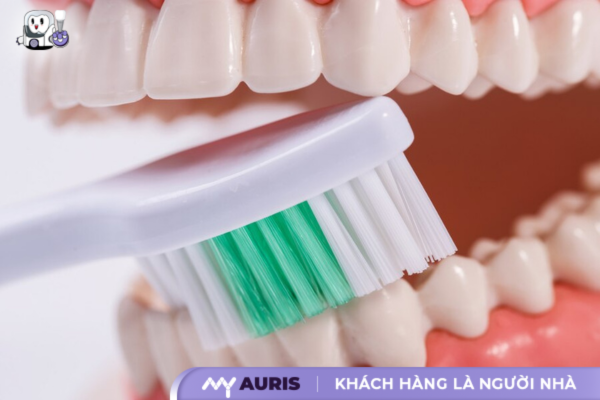
- Diet:
- First week:
- Eat soft, liquid, easy-to-chew, easy-to-swallow foods like porridge, soup, smoothies.
- Drink plenty of water.
- Avoid chewing directly on the implant site.
- After the first week:
- Gradually incorporate harder foods into your diet, but still avoid excessively hard, chewy, or crunchy foods.
- Always avoid:
- Foods and drinks that are too hot or too cold.
- Spicy, sour, salty, carbonated foods, alcohol, beer, coffee, tobacco.
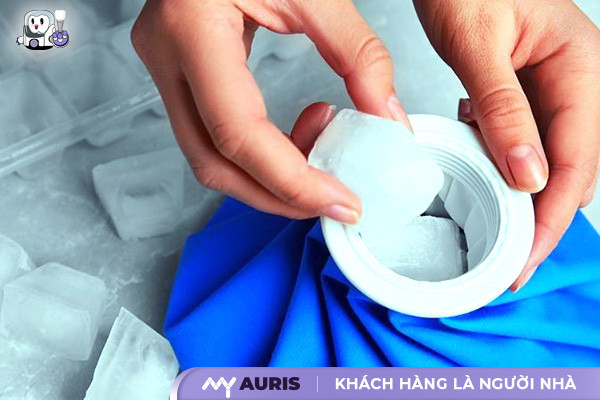
- Cold and Warm Compresses:
- Cold compress: During the first 24 hours after surgery, apply a cold compress to the outside of the cheek at the implant site for 15-20 minutes at a time, repeating every 2-3 hours. This helps effectively reduce swelling and pain.
- Warm compress: After the first 24 hours, you can switch to a warm compress to reduce bruising and swelling.
- Adhere to Medication Usage:
Use pain relievers, anti-inflammatory drugs, and antibiotics strictly as prescribed by your dentist. Do not arbitrarily stop medication or adjust dosages.
- Scheduled Follow-Up Appointments:
Attend follow-up appointments as scheduled by your dentist to monitor the healing process and check the stability of the implant.
- Maintain a Healthy Lifestyle:
- Quit smoking.
- Limit alcohol, beer, coffee, and carbonated soft drinks.
- Eat a nutritious diet, supplementing with plenty of green vegetables and fruits.
- Get enough sleep, avoid stress and anxiety.
Implant placement is an optimal tooth restoration solution that provides long-lasting results. However, after surgery, you may experience some symptoms such as pain, swelling, bleeding, etc.
Most post-implant symptoms are mild and resolve on their own after a few days. Adhering to your dentist’s care instructions is crucial for a fast healing process.

Important Notes After Dental Implant Placement
After implant placement, proper care plays a crucial role in the implant recovery process and in reducing the risk of implant complications. In addition to choosing appropriate foods and adhering to post-implant dietary restrictions, you need to pay attention to implant oral hygiene and the following important notes:
Managing bleeding after implant surgery: After implant placement, slight bleeding may occur. You should bite down firmly on a gauze pad for 30 – 60 minutes to help stop the bleeding, avoid spitting or continuously swallowing saliva, and limit disturbance to the wound.
Reducing swelling and pain: In the initial days, applying cold compresses will help reduce swelling and pain, while also limiting the risk of infection.
Take medication as prescribed by the dentist: After implant surgery, the dentist will prescribe pain relievers, antibiotics, and anti-inflammatory drugs to support the recovery process. Absolutely do not self-medicate with anything outside the prescribed list.
Limit strenuous activity: Within 48 hours after surgery, you should avoid high-intensity physical activities to prevent injury or impact on the implant post.
Do not smoke: Tobacco contains many stimulants that can impair the osseointegration process, increasing the risk of implant rejection. Therefore, refrain from smoking for at least 2 – 4 weeks after implantation.
Avoid disturbing the implant site: Do not use cotton swabs, hard objects, or your tongue to touch the wound, and prevent food from entering this area to reduce the risk of infection.
Attend scheduled implant follow-ups: Patients must adhere to the implant follow-up schedule as instructed by the dentist to monitor the jawbone integration process and detect any potential issues early. If you experience unusual symptoms such as prolonged pain, severe swelling, continuous bleeding, or fever, contact your dentist immediately.
Strictly following your dentist’s instructions and establishing a scientific post-implant care regimen will ensure a smooth recovery process, guaranteeing durable and strong dental implants for a long time.
If you experience any unusual signs, contact your dentist immediately for examination and timely treatment. Nha Khoa My Auris – where clients are family, is always with you to achieve a confident and healthy smile.






